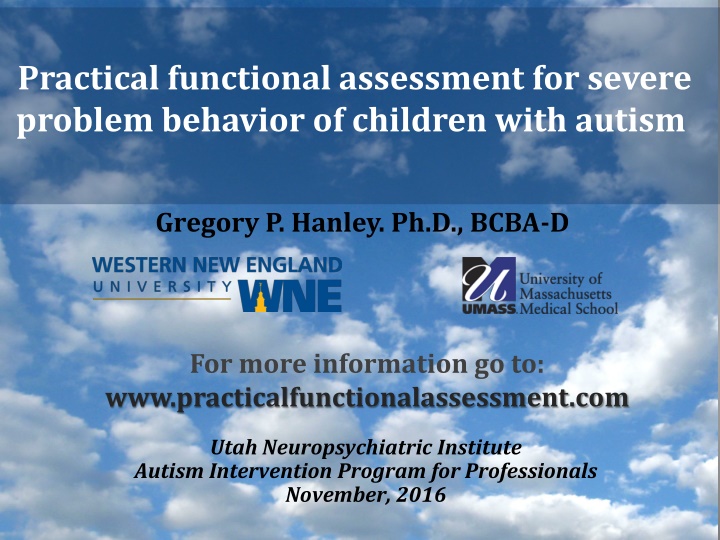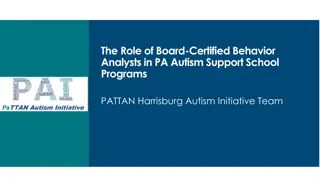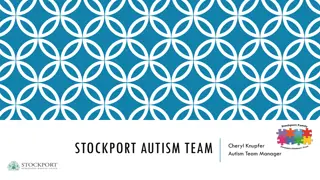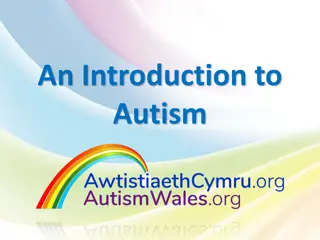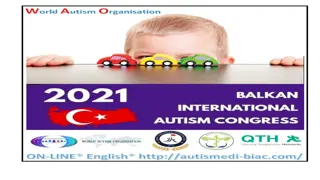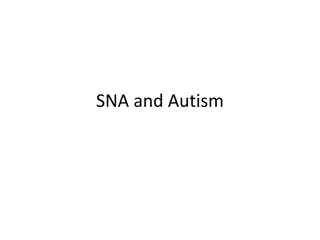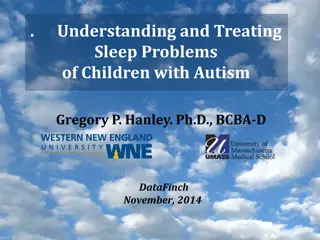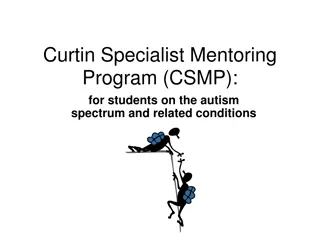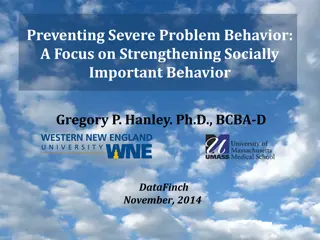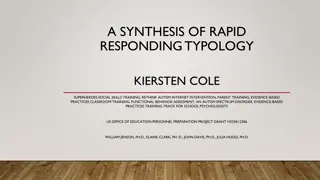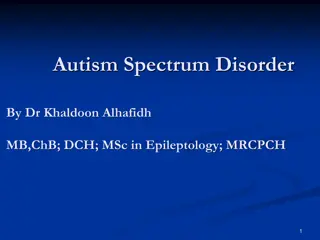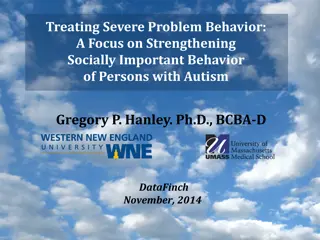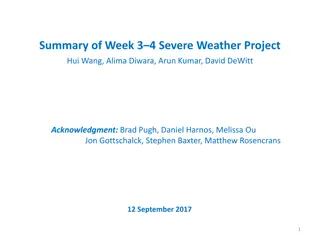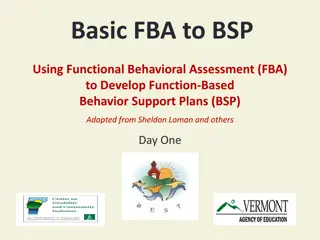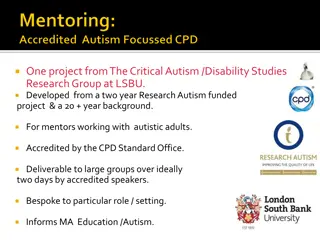Functional Assessment for Severe Problem Behavior in Children with Autism
This practical and informative material discusses functional assessments for severe problem behavior in children with autism, presenting case examples and hypotheses for behavior analysis. The process involves identifying triggers and functions of the behavior to create effective interventions. The article highlights specific cases and interventions implemented by therapists to address problem behaviors in children with autism.
Download Presentation

Please find below an Image/Link to download the presentation.
The content on the website is provided AS IS for your information and personal use only. It may not be sold, licensed, or shared on other websites without obtaining consent from the author.If you encounter any issues during the download, it is possible that the publisher has removed the file from their server.
You are allowed to download the files provided on this website for personal or commercial use, subject to the condition that they are used lawfully. All files are the property of their respective owners.
The content on the website is provided AS IS for your information and personal use only. It may not be sold, licensed, or shared on other websites without obtaining consent from the author.
E N D
Presentation Transcript
Practical functional assessment for severe problem behavior of children with autism Gregory P. Hanley. Ph.D., BCBA-D For more information go to: www.practicalfunctionalassessment.com Utah Neuropsychiatric Institute Autism Intervention Program for Professionals November, 2016
Case Example (Gail, 3 yo, dx: PDD-NOS) Therapist: Nicholas Vanselow Setting: Clinic 4 Analyst Analyst Analyst Mother Mother 3 Tangible / Attention 2 Hypotheses: 1 Gail engages in meltdowns and aggression in order to obtain: Gail Problem Behavior per Min 0 preferred (tangible) items, And maternal attention, 4 3 Test Control Tangible 2 1 0 4 3 Meltdowns Col 46 Attention 2 1 0 2 4 6 8 10 12 14 Sessions
Case Example (Bob, 8 yo, dx: Autism) Therapist: Sandy Jin Setting: Clinic 6 5 4 Escape / Tangible 3 Problem Behavior per Min Hypothesis: 2 Bob (Ipad context) 1 Bob engages in meltdowns and aggression in order to obtain: 0 14 His way in the form of escape from adult instructions and access to preferred ways of interacting with electronics or academic materials Escape / Tangible 12 10 8 6 4 Bob (Math context) 2 0 1 2 3 4 5 Sessions
Case Example (Dale, 11 yo, dx: Autism) Therapist: Sandy Jin Setting: Clinic 6 6 Problem Behavior per Min Analyst Analyst 5 5 Hypothesis: 4 Test Control Control Test 4 Escape / Tangible / Attention Attention / Mand compliance Escape / Tangible / 3 Dale engages in meltdowns and aggression in order to obtain: 3 2 2 Dale Dale 1 His way in the form of escape from adult instructions and access to preferred (tangible) items, and adult attention. 1 0 0 1 2 3 4 5 Sessions
Take a moment to reflect on this particular functional assessment process. How is it similar to and different than the process you implement? Discuss with your neighbor. Before I try to answer any questions, let me reflect on the process.
Some Important Aspects of our Approach 1. Extensive descriptive assessments are never part of the process because they are: time-consuming and usually suggest invalid relations St. Peter et al., 2005; Thompson & Iwata, 2007
Some Important Aspects of our Approach 2. Closed-ended indirect assessments (MAS, QABF, FAST) are never used in the process because they do not provide any information about personally unique or qualitative features of potentially influential variables
Some Important Aspects of our Approach 3. An open-ended interview is always part of the process (as is one brief and informal observation) Goals of interview are to: a) Develop rapport with parents or teachers b) Identify unique contingencies c) Develop function hunches d) Set up a safe and quick analysis Interviews allow for discoveries which can then be verified (or not) in a functional analysis
Some Important Aspects of our Approach 4. A standard 4 or 5 condition analysis (with the play condition as the control, e.g., Iwata et al., 1982) is never part of the process Probably a mistake to standardize a powerful and flexible tool like a functional analysis
Some Important Aspects of our Approach 5. A two-condition analysis designed from the open-ended interview is always part of the process (i.e., an interview-informed analysis) Functional analysis: Direct observation of behavior under at least two conditions in which some event is manipulated Two Conditions: Test: Contains the reinforcing contingency thought to maintain severe problem behavior Control: Does not contain the reinforcing contingency thought to maintain severe problem behavior
Some Important Aspects of our Approach 6. We synthesize multiple contingencies into one test condition, if the interview suggests the contingencies are operating simultaneously
Why might problem behavior occur? Single contingencies: 1. Attention or toys (social-positive reinforcement) 2. Escape/avoidance (social-negative reinforcement) 3. Sensory/non-social (automatic reinforcement) Combinatorial contingencies: 1. Attention and Toys 2. Escape to toys 3. Escape to toys and attention 4. Escape to automatic reinforcement 5. Compliance with mands 6. Escape to access to rituals, preferred conversations 7. Escape to controlling people or objects 8. Etc ..
Some standard analyses published a while ago
Some standard analyses published a while ago
Some standard analyses published a while ago
12Will Wayne Allen Kat (Cxt 1) Sam 8 Test Control 4 0 6Jack (Cxt 1) Keo Jeff Zeke Kat (Cxt 2) 4 2 0 6Alex (Cxt 2) Jian Chris Gary Earl Problem behavior per min 4 From Jessel, Hanley, and Ghaemmaghami (in press) 2 0 4Mike Mitch Beck Roxy Alex (Cxt 1) 3 2 1 0 2.0 Paul Dan Kristy Jim Sid 1.5 1.0 0.5 0 2.0 Steve Jesse Lee Jack (Cxt 2) Carson 1.5 1.0 0.5 0 2 6 10 2 4 6 1 3 5 1 3 5 1 3 5 Sessions
Consider an Interview Informed Synthesized Contingency Analysis IISCA? Interview-informed Synthesized Contingency Analysis Single-test condition Individualized test conditions Synthesized contingencies Test-specific control Standard Functional Analysis Multiple test conditions Uniform test conditions Isolated test contingencies Toy-play control conditions Reinforce dangerous behavior Reinforce precursors to and dangerous behavior
Slaton, J., Hanley, G., & Raftery, K. (under review, JABA)
IISCA vs. Standard Analysis IISCA Standard IISCA 2 Test Control Ignore/Alone Attention Tangible Escape 1 Play Escape to tangibles and attention Diego Problem behavior per min 0 3 Escape to tangibles and attention 2 1 Mason 0 3 Escape to tangibles 2 1 Riley 0 1 2 3 4 5 5 10 15 Sessions 4 Escape to tangibles and attention 2 0
Why was the IISCA differentiated more often than the standard analysis? Maintenance by interactions may be more prevalent than we realize IISCA Standard IISCA 2 Test Control Ignore/Alone Attention Tangible Escape 1 Play Escape to tangibles and attention Diego Problem behavior per min 0 3 Escape to tangibles and attention 2 1 Mason 0 Detecting interactions Is an advantage of the IISCA 3 Escape to tangibles 2 1 Riley 0 1 2 3 4 5 5 10 15 Sessions 4 Escape to tangibles and attention 2 0
IISCA vs. Standard Analysis IISCA Standard 2 Alone Test Attention Tangible Kyle Control Problem behavior per min Escape Play Escape to predictable schedule 1 0 2 8 Escape to tangibles, stereotypy, and attention 6 Jonah 1 4 2 0 0 5 10 15 20 25 1 2 3 4 5 Sessions 3 Escape to tangibles and attention 2 1 0 5 10 15 1 2 3 4 5
Why was the IISCA differentiated more often than the standard analysis? Standard analysis did not capture all relevant reinforcers IISCA Standard 2 Alone Test Attention Tangible Kyle Control Problem behavior per min Escape Play Escape to predictable schedule 1 0 2 8 Escape to tangibles, stereotypy, and attention 6 Jonah 1 4 2 0 0 5 10 15 20 25 1 2 3 4 5 Sessions 3 Escape to tangibles and attention 2 1 0 5 10 15 1 2 3 4 5
IISCA vs. Standard Analysis IISCA 4 Control Standard Ignore/Alone Attention Test Tangible Escape Play 2 Escape to tangibles Dylan 0 4 Escape to tangibles and attention Problem behavior per min 2 4 Escape to tangibles and attention Emily 2 0 4 0 Escape to rituals 2 Chloe 0 1 Escape to tangibles Jeff 0 2 4 6 5 10 15 20 Sessions
Treatment Comparison Results IISCA- based treatment Standard-based treatment 5 FCT + EXT BL FCT + EXT BL 4 Escape Escape to tangibles, attention Problem behavior Problem behavior per min 3 FCR 2 Emily 1 0 1 BL FCT + EXT BL FCT + EXT Attention Escape to tangibles Jeff 0 5 10 5 10 Sessions
Treatment Comparison Results IISCA- based treatment Standard-based treatment Escape 3 Escape to tangibles Problem behavior per min 2 Tangibles 1 0 Dylan 6 FCT + EXT FCT + EXT BL BL Escape Escape to rituals 4 2 Chloe 0 5 10 15 20 25 5 10 15 20 25 Sessions
But is it valid? Be wary of the unanswerable: Is that the true function? Remember our Truth Criterion: Effective Action Applied to Functional Analysis: That which is valid is that which leads to the most general and socially validated change in problem behavior
Consider an Interview Informed Synthesized Contingency Analysis IISCA Interview-informed Synthesized Contingency Analysis Single-test condition Individualized test conditions Synthesized contingencies Test-matched control Reinforce precursors to and dangerous behavior Standard Functional Analysis Multiple test conditions Uniform test conditions Isolated test contingencies Toy-play control conditions Reinforce dangerous behavior
Take Home Point Prior to treating problem behavior of children with autism 1. Conduct an open ended interview to discover the context and outcomes that seem relevant to problem behavior 2. Conduct an IISCA to demonstrate the validity of the suspected contingency and to have access to the properly motivating conditions to teach skills
Why is it important to conduct a functional assessment with a functional analysis as part of the process prior to treating severe problem behavior? a. because the functional assessment process is humane and dignifying b. because behavior modification is ineffective c. because research reviews show that more effective treatments result from functional assessment processes, especially those that contain a functional analysis
Why is it important to conduct a functional assessment with a functional analysis as part of the process prior to treating severe problem behavior? a. because the functional assessment process is humane and dignifying b. because behavior modification is ineffective c. because research reviews show that more effective treatments result from functional assessment processes, especially those that contain a functional analysis
Identify the functional assessment tools that can be omitted from an effective functional assessment process of severe problem behavior. a. closed ended indirect assessment and functional analysis b. open-ended indirect assessment and formal descriptive assessment c. closed-ended indirect assessments and formal descriptive assessments d. open-ended indirect assessment and functional analysis
Identify the functional assessment tools that can be omitted from an effective functional assessment process of severe problem behavior. a. closed ended indirect assessment and functional analysis b. open-ended indirect assessment and formal descriptive assessment c. closed-ended indirect assessments and formal descriptive assessments d. open-ended indirect assessment and functional analysis
What are the essential components of a functional analysis of problem behavior? a. direct observation of problem behavior during least 4 rapidly alternating conditions (demand, attention, alone, and toy play) b. direct observation of problem behavior in a condition containing the reinforcing contingency thought to maintain severe problem behavior and one condition in which this contingency is absent c. indirect observation of problem behavior during several test conditions and a toy play control condition d. direct observation of problem behavior in the natural environment
What are the essential components of a functional analysis of problem behavior? a. direct observation of problem behavior during least 4 rapidly alternating conditions (demand, attention, alone, and toy play) b. direct observation of problem behavior in a condition containing the reinforcing contingency thought to maintain severe problem behavior and one condition in which this contingency is absent c. indirect observation of problem behavior during several test conditions and a toy play control condition d. direct observation of problem behavior in the natural environment
Nominate the essential features of an interview informed synthesized contingency analysis (IISCA) a. Test-matched control condition b. Interview-informed synthesized contingency c. Single and individualized test condition d. Reinforcement programmed for precursors to and dangerous behavior
Nominate the essential features of an interview informed synthesized contingency analysis (IISCA) a. Test-matched control condition b. Interview-informed synthesized contingency c. Single and individualized test condition d. Reinforcement programmed for precursors to and dangerous behavior
What does an informed analysis provide the behavior analytic practitioner?
What does an informed analysis provide the behavior analytic practitioner? a. a demonstration of problem behavior sensitivity to a suspected reinforcement contingency b. the truth regarding the variables controlling problem behavior c. a stable and sensitive baseline from which to evaluate treatment d. a properly motivating set of conditions to teach functional communication and delay tolerance
What does an informed analysis provide the behavior analytic practitioner? a. a demonstration of problem behavior sensitivity to a suspected reinforcement contingency b. the truth regarding the variables controlling problem behavior c. a stable and sensitive baseline from which to evaluate treatment d. a properly motivating set of conditions to teach functional communication and delay tolerance
Come up with at least one question relevant to conducting the functional assessment process.
Lets role play some functional analyses. Hand-to head-SIB and groaning appear to be maintained by: 1. Tangibles 2. Escape from demands to access tangibles 3. Escape from demands to access tangibles, attention, and stereotypy 4. Compliance with the child s mands (Escape from the teacher s way to access the child s way)
Lets design analyses from interview results. Some tips: 1. Do not put responses in contingency class that are likely to be maintained by automatic sr. 2. Do consider putting mands (e.g., protests) in the contingency class if severity of pb is outrageous. 3. Incorporate the most challenging and convenient EOs. Use challenging and inconvenient EOs as tests of treatment generality 4. Conduct analysis where you have the most control and will be able teach the skills. 5. Err on the side of synthesizing too many contingencies rather than too few.
1.0 Problem behavior per m in C ontrol E scape/ T angible/ A ttention / R equest com pliance T est 0.5 0.0 1 2 3 4 5 6 7 8 S essio n s
Good luck with all that you do for all who you teach and provide care For more information go to: www.practicalfunctionalassessment.com Contact info.: Gregory P. Hanley, Ph.D., BCBA-D Psychology Department Western New England University 1215 Wilbraham Road Springfield, Massachusetts 01119 ghanley@wne.edu
